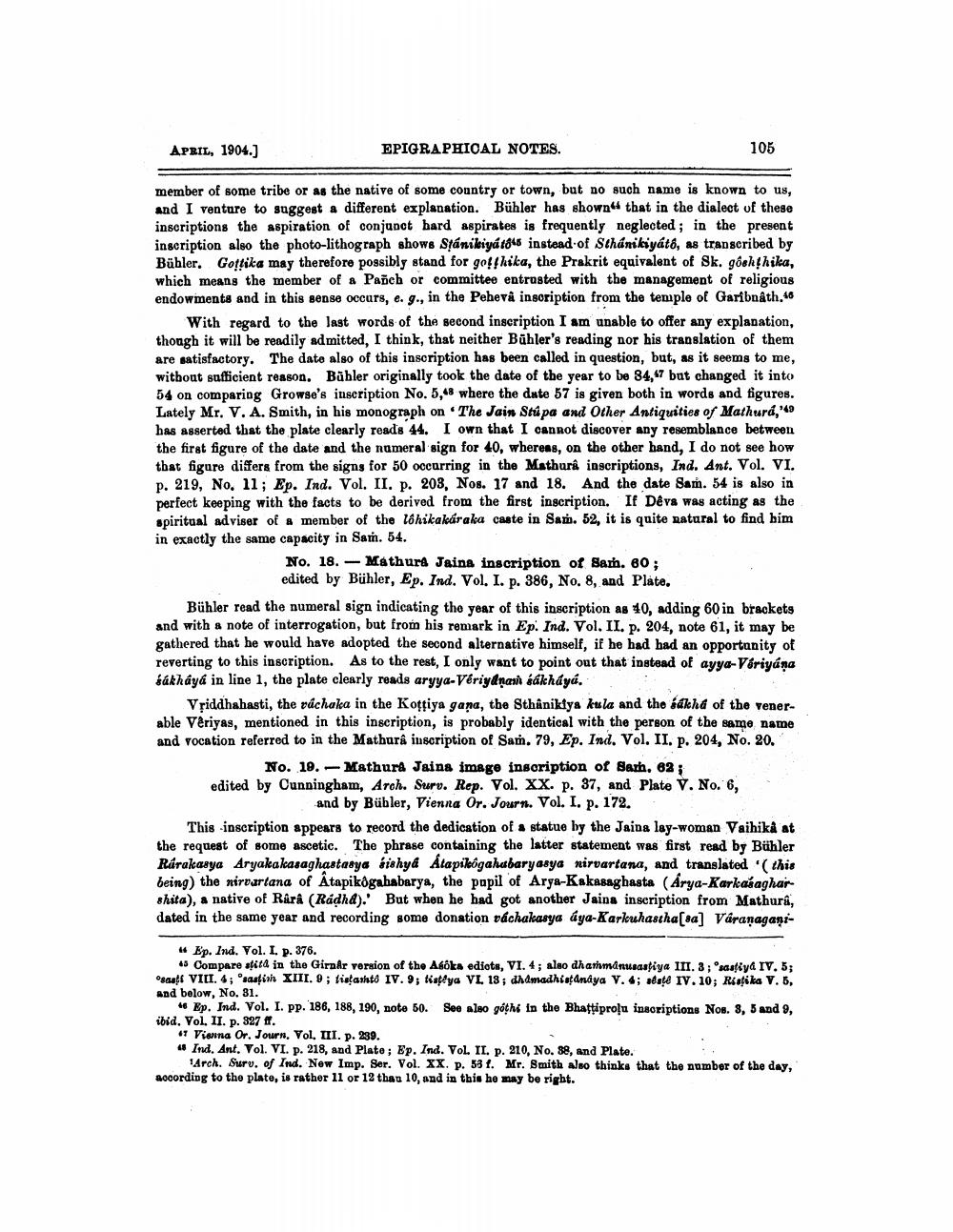________________
APRIL, 1904.)
EPIGRAPHICAL NOTES.
105
member of some tribe or as the native of some country or town, but no such name is known to us, and I venture to suggest a different explanation. Bühler has shown that in the dialect of these inscriptions the aspiration of conjunct hard aspirates is frequently neglected; in the present inscription also the photo-lithograph shows Stániliyá t846 instead of Sthánikiyatë, as transcribed by Bühler. Gottika may therefore possibly stand for gothika, the Prakrit equivalent of Sk. goshthika, which means the member of a Papeb or committee entrusted with the management of religious endowments and in this sense occurs, e. g., in the Pehevå insoription from the temple of Garibnáth,66
With regard to the last words of the second inscription I am unable to offer any explanation, though it will be readily admitted, I think, that neither Bühler's reading nor his translation of them are satisfactory. The date also of this inscription has been called in question, but, as it seems to me, without sufficient reason. Būbler originally took the date of the year to be 84,7 but changed it into 54 on comparing Growse's inscription No. 5,48 where the date 57 is given both in words and figures. Lately Mr. V. A. Smith, in his monograph on The Jain Stúpa and Other Antiquities of Mathurd,"49 has asserted that the plate clearly reads 44. I own that I cannot discover any resemblance between the first figure of the date and the numeral sign for 40, whereas, on the other hand, I do not see how that figure differs from the signs for 50 occurring in the Mathurê inscriptions, Ind. Ant. Vol. VI. p. 219, No. 11; Ep. Ind. Vol. II. p. 203, Nos. 17 and 18. And the date Sam. 54 is also in perfect keeping with the facts to be derived from the first inscription. If Dêva was acting as the spiritual adviser of a member of the lohikakáraka caste in Sam. 52, it is quite natural to find him in exactly the same capacity in San. 54.
No. 18. - Mathura Jains inscription of San. 60;
edited by Bühler, Ep. Ind. Vol. I. p. 386, No. 8, and Pláte, Bühler read the numeral sign indicating the year of this inscription as 40, adding 60 in brackets and with a note of interrogation, but from his remark in Ep. Ind. Vol. II. p. 204, note 61, it may be gathered that he would have adopted the second alternative himself, if he had had an opportanity of reverting to this inscription. As to the rest, I only want to point out that instead of ayya-Váriyána bákháyá in line 1, the plate clearly reads aryya-Vériyanan säkháyć.
Vriddhahasti, the vachaka in the Kottiya gana, the Sthâniklya kula and the óákhá of the venerable Vériyas, mentioned in this inscription, is probably identical with the person of the same name and vocation referred to in the Mathurâ inscription of Sam. 79, Ep. Ind. Vol. II. p. 204, No. 20.
No. 19. -Mathura Jains image inscription of Sam, 62; edited by Cunningham, Arch. Surv. Rep. Vol. XX. p. 37, and Plate V. No. 6,
and by Bübler, Vienna Or. Journ. Vol. I. p. 172. This inscription appears to record the dedication of a statue by the Jaina lay-woman Vaihika at the request of some ascetic. The phrase containing the latter statement was first read by Bühler Rárakasya Aryakakasaghastasya bishya Atapilógahabaryasya nirvartana, and translated this being) the nirvartana of Atapikôgahabarya, the papil of Arya-Kakasaghasta (Arya-Karkasaghar shita), a native of Rara (Radhd). But when he had got another Jaina inscription from Mathura, dated in the same year and recording some donation váchakasya aya-Karkuhastha[sa] Váranagani
4 Ep. Ind. Yol. I. p. 376.
45 Compare sfit& in the Girnar version of the Asöka edista, VI. 4; also dharmanusaatiya III. 3 ; osasfiya IV. 5; saat VIII. 4; saatish XIII. 9; Natashto IV. 9; tistêya VL 13; dhamadhi of Andya V. 4; a IV. 10; Reafika V. 5, and below, No. 31.
- Ep. Ind. Vol. I. pp. 186, 188, 190, note 50. See also gothi in the Bhattaproļu inaoriptions Nos. 3, 5 and 9, ibid. Vol. II. p. 327 ff.
+7 Vienna Or. Journ. Vol. III. p. 239. 4 Ind. Ant. Vol. VI. p. 218, and Plato ; Ep. Ind. Vol. II. p. 210, No. 88, and Plate.
Arch. Surv. of Ind. New Imp. Ser. Vol. XX. p. 531. Mr. Smith also thinks that the number of the day, according to the plate, is rather 11 or 12 than 10, and in this he may be right.




